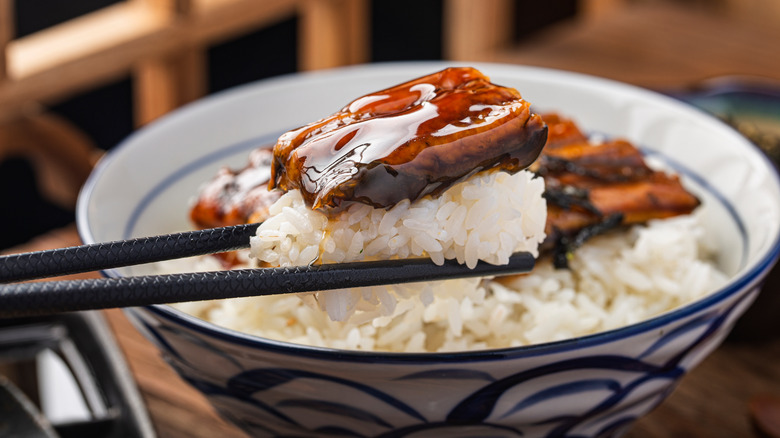Is Eel Sauce Actually Made From Eel?
If you ever go out for sushi or have been looking to explore the basics of Japanese cuisine in your home kitchen, you may come across a condiment called eel sauce. If you have a seafood allergy or you're just trying to eat more plant-based foods, the sauce may initially be cause for concern due to its name. Fortunately, eel sauce is totally safe for those avoiding seafood.
Despite its name, eel sauce doesn't actually contain any eel. Instead, the sauce combines sake, mirin (a sweet Japanese rice wine), sugar, and soy sauce. Those ingredients are all added into a pan and reduced, thickening the mixture into a stickier consistency to garnish cooked dishes and sushi rolls.
The sauce's primary flavor comes from the umami-rich soy sauce, which is sweetened thanks to the mirin and added sugar. Its flavor has been compared to teriyaki sauce, though the latter often uses other ingredients like honey and ginger to achieve its sweet-and-savory taste.
The sauce pairs well with a variety of dishes
The condiment goes by a few different names. The most common is eel sauce, but it is also called kabayaki sauce or unagi no tare (unagi is freshwater eel). It's considered a variation of nitsume, which classically does contain the wriggly sea creature — the main difference being that, historically, nitsume used a stock made from eel as its base in addition to the other ingredients.
But if the standard modern formulation doesn't contain any eel, why did the name stick? It's likely due to its association with eel dishes. The sauce was more or less created to accentuate eel in dishes like unadon (grilled eel over rice), umaki (omelet rolled around grilled eel), or unagi nigiri (glazed eel sushi).
While it is frequently enjoyed in these eel-based recipes, it can also be a delicious addition to other grilled proteins, like fish and chicken. The sweet-and-savory flavors of the sauce give dishes an extra element of sweet and savory flavor. "Top Chef" alum and James Beard Award winner Stephanie Izard uses unagi sauce (she thickens hers with mayonnaise) to elevate Caprese and stone fruit salads in place of balsamic vinegar.
How to make your own eel sauce
Although shelf-stable versions can be purchased in stores, eel sauce is pretty easy to make at home, so long as you have the correct ingredients. Soy sauce acts as the foundation, providing much of the flavor (it also works great as a 'secret ingredient' in other dishes), while mirin helps give the sauce its shine. Combine equal amounts of soy sauce and mirin, plus a few tablespoons of sake and granulated white sugar.
Combine the ingredients in a saucepan on the stove, and turn the heat to medium. Stir carefully, and allow it to come to a simmer. As the liquid boils, it will reduce. When you have about ⅔ left of what you started with, the sauce should be done. Once it cools, test its consistency. If it's syrupy without being overly sludgy, it's good to go. If it's too thin, you can keep cooking it down. If it's too thick, mix in some water or chicken broth until you achieve the correct thickness.
Once your eel sauce is done, pair it with your favorite eel-based dish, unagi and anago sushi rolls, tomato salads, or various grilled proteins for that signature sweet-and-savory flavor.


